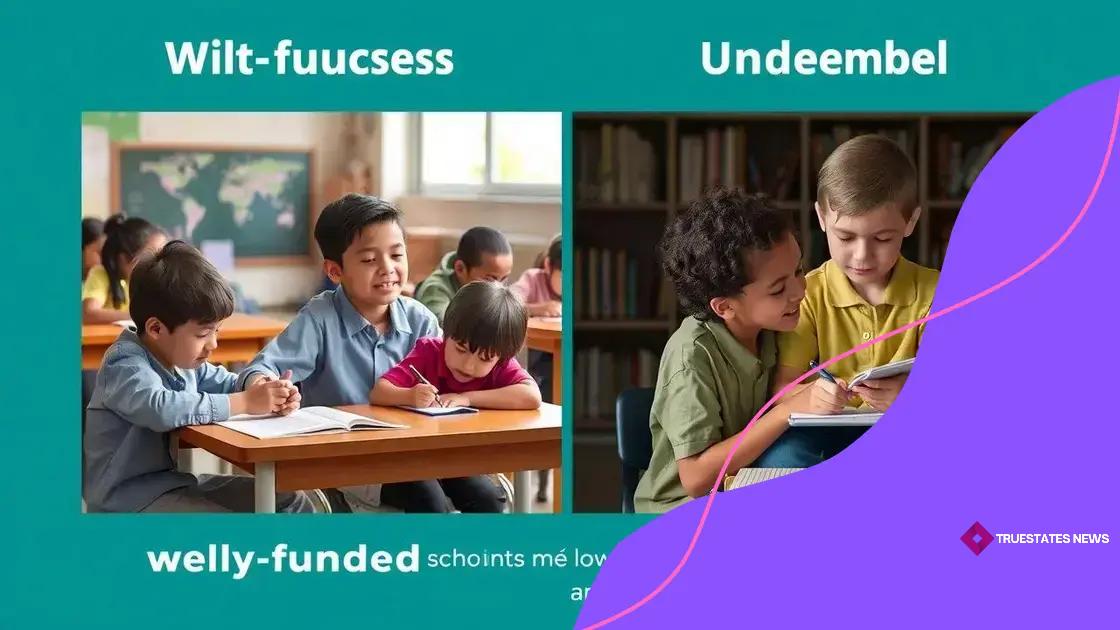School funding disparity: How it affects student success

School funding disparity refers to the unequal distribution of financial resources among schools, often negatively impacting student success and leading to poorer educational outcomes in underfunded areas.
School funding disparity affects students more than you might think. Have you ever wondered how money influences education quality? Let’s dive in and explore this critical issue.
Understanding school funding disparity
Understanding school funding disparity is crucial for grasping how education systems operate. This issue is often overlooked but has significant implications for students and communities.
What is school funding disparity?
School funding disparity refers to the unequal distribution of resources among schools. Factors like local property taxes largely contribute to this imbalance. Wealthier neighborhoods generate more revenue, allowing their schools to have better facilities, teachers, and supplies.
Key Factors Contributing to Funding Gaps
- Reliance on local property taxes
- State funding policies
- Differences in school district wealth
- Economic challenges in low-income areas
These factors create a cycle where schools in poorer areas struggle to provide the quality education that students deserve. The consequences are profound and affect all aspects of a child’s educational experience.
Effects on Students
The impacts of school funding disparity on students are far-reaching. Students in underfunded schools may face larger classroom sizes, fewer advanced placement courses, and limited extracurricular activities. This lack of resources can hinder their ability to perform well academically.
In addition, these disparities can lead to feelings of inadequacy and lower self-esteem among students. When children in wealthier districts receive more opportunities, those in underserved schools miss out on the skills that are necessary for their future success.
Communities recognize the need to combat these disparities. Many advocate for fairer state funding policies and seek to raise awareness about the implications of unequal educational resources. By addressing these funding issues, we can help ensure that all students receive a quality education.
Factors contributing to funding gaps
Several key factors play a role in creating funding gaps among schools. Understanding these factors is essential in addressing the disparities in education. One major contributor is the reliance on local property taxes for school funding.
Property Taxes and School Funding
Many schools receive funding primarily from local property taxes, which means wealthier areas can raise more money. This disparity creates a situation where schools in low-income neighborhoods struggle to meet basic needs.
State Funding Policies
State funding policies also significantly impact funding gaps. States have different approaches to allocating funds, and often, districts with less wealth receive less support.
- Equity in distribution varies greatly.
- Some states prioritize urban districts over rural ones.
- Many districts face budget cuts due to state laws.
- Funding formulas may not reflect actual needs.
Furthermore, administrative challenges can arise, where districts with strong leadership are better at leveraging resources. Conversely, those without effective leadership may find it hard to advocate for the funds they need. Economic challenges in surrounding communities also contribute to funding gaps.
When communities face high unemployment rates, it affects property values. This decline can lead to less revenue for schools, making it harder to provide quality education. It is clear that these factors intertwine to create a complex web of inequality in school funding.
Effects on student success and outcomes

The effects on student success due to funding disparities are profound and far-reaching. Students in well-funded schools often have access to more resources, which can significantly impact their educational outcomes.
Access to Resources
Students who attend schools with adequate funding typically enjoy numerous advantages. These include smaller class sizes, advanced coursework options, and a variety of extracurricular activities.
- More individualized attention from teachers.
- Access to technology and learning materials.
- Opportunities for advanced placement or honors courses.
- Various clubs and sports to enhance social development.
In contrast, schools facing funding gaps struggle to provide these essential services. Larger class sizes can make it challenging for teachers to meet individual student needs. Additionally, limited access to technology can hinder learning and engagement.
Impact on Academic Performance
Research shows a clear link between funding disparities and academic performance. Schools with less funding tend to have lower test scores and graduation rates. This can lead to a cycle of disadvantage that affects students long-term.
Students in underfunded schools may feel demotivated or unsupported, impacting their overall self-esteem and aspiration. Such challenges can further perpetuate the educational gaps, making it even harder for these students to improve their circumstances in the future.
Addressing the impacts of funding disparities is essential to ensure all students have the opportunity to succeed academically. By focusing on equity in education funding, we can help bridge these gaps and promote better outcomes for every child.
Community responses to funding challenges
Community responses to funding challenges in schools demonstrate the power of collective action. Many communities are stepping up to advocate for more equitable education resources.
Grassroots Movements
Grassroots movements have emerged across the country to address the disparities in school funding. Parents, teachers, and community members come together to raise awareness and demand change. These movements often focus on the need for:
- Increased local funding through taxes or donations.
- Support for state-level policy reforms.
- Awareness campaigns to educate the public on funding issues.
- Collaborations with local businesses to secure resources.
Through these efforts, communities aim to highlight the importance of adequate funding for all schools. They understand that when schools have adequate resources, students thrive academically.
Partnerships and Initiatives
Communities are also forming partnerships with local organizations to directly support their schools. Initiatives like after-school programs, tutoring, and mentorship are developed to fill in the gaps left by funding shortages. These programs often provide:
- Additional academic support to struggling students.
- Social-emotional learning resources for better student well-being.
- Opportunities for community engagement among families and educators.
- Access to technology for students who may lack resources at home.
Such community-driven initiatives not only support students but also foster a sense of ownership and responsibility within the community. They are a testament to the idea that a collaborative effort can lead to significant change, helping to reduce the effects of funding disparities.
Strategies for addressing school funding disparities
There are several effective strategies for addressing school funding disparities that can help create a more equitable educational landscape. Communities and policymakers can take steps to ensure that all students have access to the resources they need.
Advocating for Policy Changes
One of the most important strategies is advocating for policy changes at the state level. This involves:
- Engaging with local legislators to support equitable funding formulas.
- Promoting transparency in how funds are allocated to schools.
- Encouraging the implementation of programs that prioritize underfunded districts.
- Lobbying for increased state aid to schools in low-income areas.
When communities come together to advocate for stronger policies, they can influence funding decisions and push for reforms that benefit all students.
Creating Community Partnerships
Another effective approach is to foster partnerships with local organizations and businesses. These partnerships can provide additional resources and support to schools that need them most. For example, local businesses can:
- Donate funds or supplies to under-resourced schools.
- Offer internships or job shadowing opportunities for students.
- Help sponsor after-school programs.
- Participate in mentorship initiatives that connect students with professionals.
By establishing strong community ties, schools can access a network of support that enhances educational offerings and fosters student development.
Improving the funding situation for schools facing disparities requires active involvement from various stakeholders. Parents, educators, and community leaders must collaborate to find innovative solutions that bridge the funding gaps and promote equal opportunities for every student.
FAQ – Frequently Asked Questions about School Funding Disparities
What are school funding disparities?
School funding disparities refer to the unequal distribution of financial resources across schools, often based on local property taxes.
How do funding disparities affect student success?
Funding disparities can lead to larger class sizes, fewer resources, and lower academic performance for students in underfunded schools.
What can communities do to address these disparities?
Communities can advocate for policy changes, form partnerships with local organizations, and raise awareness about the importance of equitable funding.
Why is advocacy important in education funding?
Advocacy is crucial because it helps influence policymakers to implement fair funding practices and ensures all students have access to quality education.
